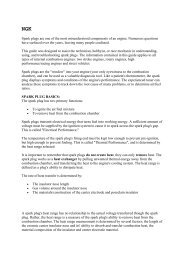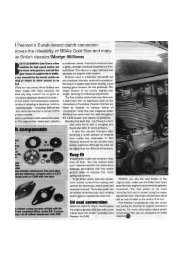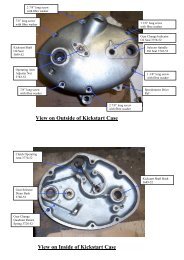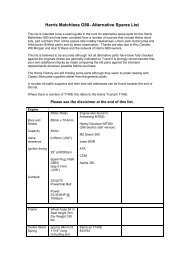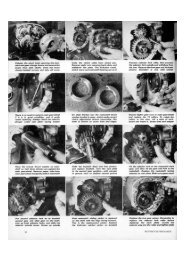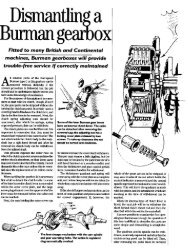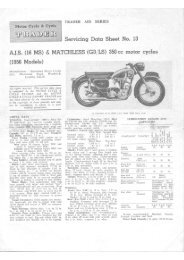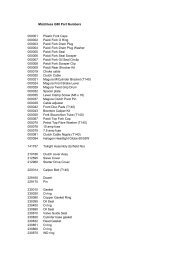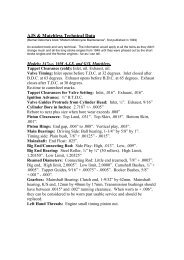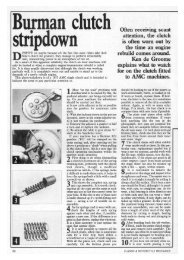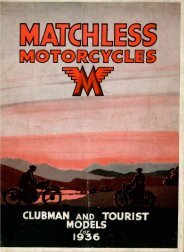THE ATLAS HYBRIDS - AJS and Matchless Archives
THE ATLAS HYBRIDS - AJS and Matchless Archives
THE ATLAS HYBRIDS - AJS and Matchless Archives
You also want an ePaper? Increase the reach of your titles
YUMPU automatically turns print PDFs into web optimized ePapers that Google loves.
On really quick bends the Featherbed had a controlled 'drift' whilst the G.15 C.S.R. had a tendency for a<br />
slight rear-end weave. Vibration was similar but slightly less on the G.15 C.S.R. for some unknown<br />
reason but neither were excessive in this. The vibration (only at high revs) on the <strong>Matchless</strong> engined<br />
G.12 C.S.R. however was high-pitched, sonic <strong>and</strong> destructive, yet for normal use this machine was the<br />
least fussy of the three, albeit with less power available.<br />
Servicing was easier on the Featherbed but the alloy chaincase on the C.S.R. was a better arrangement,<br />
however bearing in mind the machines were new, there were no oil leaks from the Norton chaincase<br />
either. The <strong>Matchless</strong> was more comfortable on long journeys or when carrying a pillion passenger but<br />
the Norton was more easy to manoeuvre in traffic conditions. The Atlas centre-st<strong>and</strong> foot-peg had to be<br />
cut off for safety on fast corners but even so the Featherbed would still ground before the C.S.R.<br />
Exhaust notes were all very 'healthy,' but I must confess a preference for the deep 'burble' of the<br />
<strong>Matchless</strong> 650 engine.<br />
Styling is more of a personal requiremen; perhaps the smooth lines of the Norton Atlas or the aggressive<br />
lines of the C.S.R. reflect the hidden personality of the owner. Should anyone own both an Atlas <strong>and</strong> a<br />
G.15 C.S.R., Hycam can now offer psychiatric help! Note: take care not to interchange the rear wheel<br />
spindle spacers of these two machines - they are of different lengths. Therefore it would appear that<br />
personal taste played (<strong>and</strong> still plays) a large part in the comparison of two of the fastest machines of<br />
that time.<br />
AMC employed 'series production' during this period which meant that improvements, modifications <strong>and</strong><br />
new styling would be introduced into the next batch of machines, instead of waiting for the traditional<br />
'show' time, therefore there will be many instances of overlap with intermediate models to the stated<br />
changes in this article. However the introduction of the six-start oil pump gears, <strong>and</strong> the change from<br />
magneto <strong>and</strong> Monoblocs to coils <strong>and</strong> Concentrics occurred at the same time on the G.15 series as on<br />
the Featherbed Atlas.<br />
The chromatic paint finishes referred to (e.g. C<strong>and</strong>y Apple Red) were achieved by applying the top<br />
colour over a silver base giving a transluscent effect <strong>and</strong> thus the more coats applied - the deeper the<br />
shade. This sometimes caused shadowing if the colour was not applied evenly <strong>and</strong> also caused<br />
variations in the shade from batch to batch.<br />
Perhaps it would be in order here to compare the differences in performance with a st<strong>and</strong>ard Atlas<br />
engine fitted with magneto <strong>and</strong> Monoblocs <strong>and</strong> then coil <strong>and</strong> Concentrics. There is no question to my<br />
mind that the magneto/Monobloc set-up provides far more flat-out power reflected in overall quicker<br />
performance but with a price to pay. Coil/Concentrics make for easier 'hot' starting, smoother<br />
performance, a more even tickover <strong>and</strong> far better fuel consumption. However, my own preference is for<br />
magneto <strong>and</strong> opposite Monoblocs 389/689 because assuming the carburettor bodies are not distorted,<br />
(sometimes they distort only when hot causing all manner of problems), then you have a compromise<br />
with good performance <strong>and</strong> reasonable fuel consumption.<br />
The early twin-carb. Atlas engine with two 389 bodies, the right-h<strong>and</strong> one having the fuel chamber<br />
chopped off, were exceptionally heavy on fuel. The 1964 Atlas described had this arrangement <strong>and</strong> with<br />
the air-filter removed, the main jets recommended were 440 returning a consumption figure under hard<br />
riding of 35 mpg! But did it go! On several occasions under favourable conditions it pulled 6800 rpm in<br />
top (without clutch-slip) giving 117 mph. The main jets for opposite Monoblocs 389/689 should be about<br />
360, returning about 50 mpg on average riding, <strong>and</strong> for Concentrics the jets should be about 260,<br />
returning about 60 mpg.



